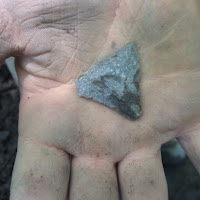 |
| Galick Farm where the dig has been taking place. |
 |
| Arrow head found during the dig the CTES 6th graders participated in. |
An open house is being held on Saturday, Sept. 16. If interested in participating, meet at the CHS Museum at 9 am. We will carpool to the site-a little over an hour from Cavendish. In addition to seeing the site, there will be a display of artifacts found some of which date back to the Paleo Indian period, more than 11,000 years ago.There will be plenty of opportunity to explore that area.

The
South Champlain Historical Ecology Project (SCHEP) is is a collaboration
between the Vermont
Archaeological Society, Castleton University, The Nature Conservancy, the Vermont Division
for Historic Preservation, and the U.S. Forest Service designed to document
long-term human-environment interaction in the southern portion of the Lake
Champlain Basin.
The
dig takes place at the Galick Site (VT-RU-71), a large Pre contact campsite and
historical farmstead in West Haven, VT. Located on the
historic Galick Farm property, it is part of The Nature Conservancy’s Helen W. Buckner
Preserve at Bald Mountain.
The Buckner Preserve is one of the most biologically
diverse settings in Vermont and is home to many of the state’s rare or
endangered species, including the timber rattlesnake and the five-lined
skink, and yes we've seen both this summer.
 |
| Timber Rattlesnake that showed up one afternoon where we were digging. |
The southern end of Lake Champlain is also an important crossroads
for long-distance transportation, with the northern terminus of a historical
portage and later canal route to the Hudson River located just to the south at
Whitehall, NY. This constellation of features made the Galick Farm area
an important location in the early history of Vermont and a rich setting for a
wide range of settlement and subsistence activities throughout the Precontact
and Historical eras.
The Galick Site was first identified as a potentially important Precontact site in 1969 by Richard Passino. In the 1970s, Dean Snow and students from SUNY Albany excavated a dozen shovel tests at the site as part of the Lake George Project. More recently, personnel from the Vermont Division for Historic Preservation identified other sites on the Galick Farm property. In addition, numerous archaeologists and 20th century visitors examined the large collection of artifacts William Galick and his family had found on their farm. Although no exhaustive inventory was made before the present, notes on the collection by Passino and others indicated an extensive and long-term Native American presence in the area.
The Galick Site was first identified as a potentially important Precontact site in 1969 by Richard Passino. In the 1970s, Dean Snow and students from SUNY Albany excavated a dozen shovel tests at the site as part of the Lake George Project. More recently, personnel from the Vermont Division for Historic Preservation identified other sites on the Galick Farm property. In addition, numerous archaeologists and 20th century visitors examined the large collection of artifacts William Galick and his family had found on their farm. Although no exhaustive inventory was made before the present, notes on the collection by Passino and others indicated an extensive and long-term Native American presence in the area.
Investigations
in 2016 included the excavation of 78 Phase I shovel test pits across an area
of approximately 5,500 m2 and the analysis of several thousand artifacts.
SCHEP also began the process of cataloguing the extensive William Galick
Collection.
If you have questions about this event, please e-mail margocaulfield@icloud.com or call 802-226-7807.
No comments:
Post a Comment